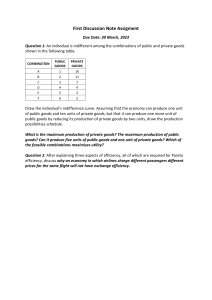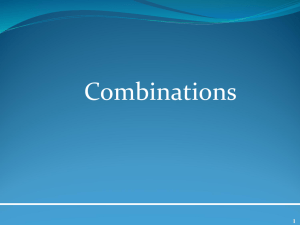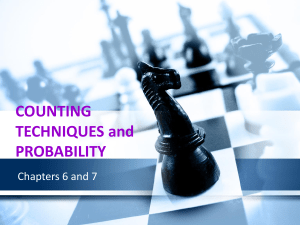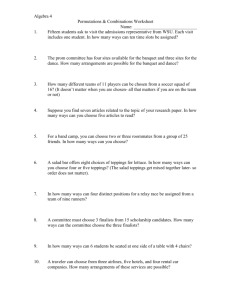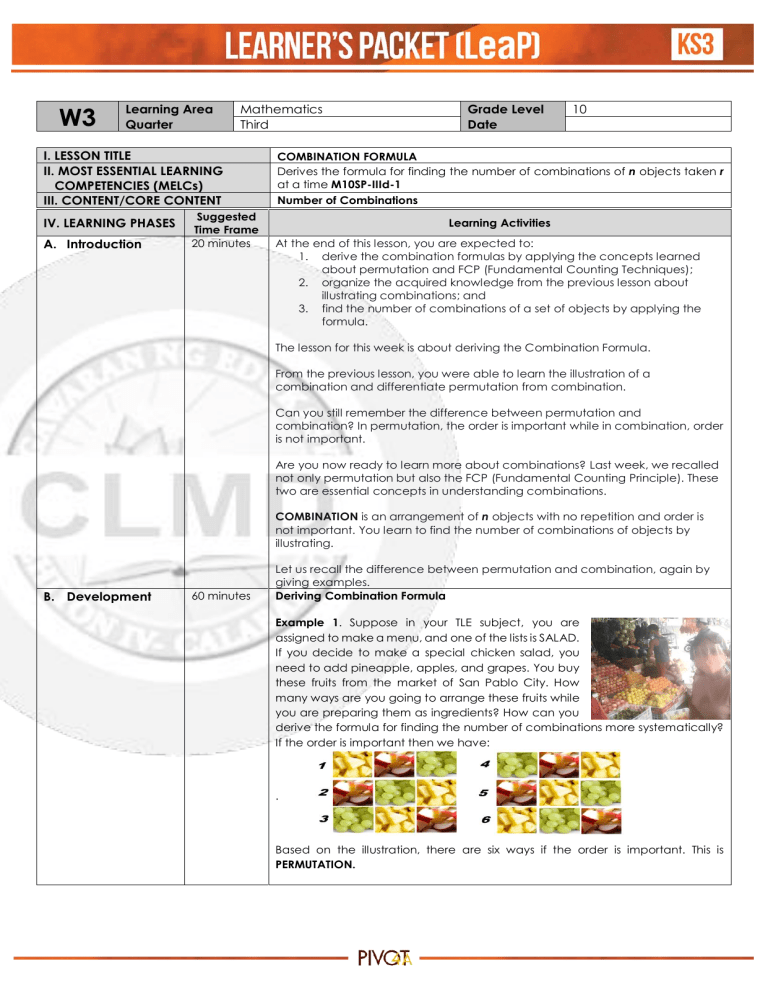
W3 Learning Area Quarter Mathematics Third I. LESSON TITLE II. MOST ESSENTIAL LEARNING COMPETENCIES (MELCs) III. CONTENT/CORE CONTENT IV. LEARNING PHASES A. Introduction Suggested Time Frame 20 minutes Grade Level Date 10 COMBINATION FORMULA Derives the formula for finding the number of combinations of n objects taken r at a time M10SP-IIId-1 Number of Combinations Learning Activities At the end of this lesson, you are expected to: 1. derive the combination formulas by applying the concepts learned about permutation and FCP (Fundamental Counting Techniques); 2. organize the acquired knowledge from the previous lesson about illustrating combinations; and 3. find the number of combinations of a set of objects by applying the formula. The lesson for this week is about deriving the Combination Formula. From the previous lesson, you were able to learn the illustration of a combination and differentiate permutation from combination. Can you still remember the difference between permutation and combination? In permutation, the order is important while in combination, order is not important. Are you now ready to learn more about combinations? Last week, we recalled not only permutation but also the FCP (Fundamental Counting Principle). These two are essential concepts in understanding combinations. COMBINATION is an arrangement of n objects with no repetition and order is not important. You learn to find the number of combinations of objects by illustrating. B. Development 60 minutes Let us recall the difference between permutation and combination, again by giving examples. Deriving Combination Formula Example 1. Suppose in your TLE subject, you are assigned to make a menu, and one of the lists is SALAD. If you decide to make a special chicken salad, you need to add pineapple, apples, and grapes. You buy these fruits from the market of San Pablo City. How many ways are you going to arrange these fruits while you are preparing them as ingredients? How can you derive the formula for finding the number of combinations more systematically? If the order is important then we have: . Based on the illustration, there are six ways if the order is important. This is PERMUTATION. IV. LEARNING PHASES Suggested Time Frame Learning Activities But if the order is not important you have, then you have the illustration bellow: There is only one way. This is called COMBINATION. Since you learned Permutation formula for the objects taken at all time is P(n, r), where n = r There are six possible ways if the order is important, however, let us have the number of combinations. This does not consider the importance of order. If by illustration the number of combinations is one, then we can conclude that one is the answer for the number of combinations of objects taken all at a time. If the permutation of objects taken all at a time is nPn, then the combination of objects taken at a time is nCn. Therefore, for COMBINATION we have : C(n , r) = C(n,n) or nCn = nCn = 𝑛𝑃𝑛 𝑛! =1 Therefore : 3C3 = 1 Example 2. One day, a friend of yours visited you and fortunately, you are going to visit your farm. He goes with you there. Then, you think of giving him a set of fruits, and these are the combination of fruits that you can find in your orchard: buko, tamarind, rambutan, and caimito. How many combinations can you make if you select only three fruits out of four choices? By illustration: buko - tamarind – rambutan caimito – buko - rambutan tamarind – rambutan – caimito caimito – buko – tamarind There are 4 combinations that you can make by illustrating. IV. LEARNING PHASES Suggested Time Frame Learning Activities Let us derive the formula: The number of different orders of four fruits taken three at a time is given by: There are 24 possibilities if order is significant, but we are looking for the formula for finding the number of COMBINATION. If P(4,3) is for permutation, then C(n,r) is for combination. Since C(n, r) = C( 4,3) = 4 = You know that 6 = (3)(2)(1) = 3! Therefore, we have If we let 4 = n; r = 3, then, the formula for finding the number of combinations of n objects taken r at a time is: Where: n > r > 0 C. Engagement 60 minutes Learning Task 1: Flex that Brain! Find the missing value in each item. 1. C(8, 3) = ___ 2. C(n, 4) = 15 3. C(9, 9) = ____ Learning Task 2: Choose Wisely, Choose Me! Solve the following problems completely. 1. 2. 3. If there are 12 teams in a basketball tournament and each team must play every other team in the eliminations, how many elimination games will there be? If there are seven distinct points on a plane with no three are collinear, how many different polygons can form? How many different sets of five cards each can arrange from a standard deck of 52 cards? IV. LEARNING PHASES Suggested Time Frame Learning Activities Learning Task 3: Derive and Find! Derive the formula for finding the number of combinations of the following situations: 1. Looking at the beautiful sky of a very peaceful night, you recognize the Constellation Libra; it has shown six stars. Suppose you consider those stars as six distinct points on a plane. How many polygons can be formed? 2. In how many ways can a MathSci Committee of five be formed from seven Math lovers and five Science lovers if the committee must have three Math lovers? D. Assimilation 20 minutes Level Up! Do this in your Journal Notebook. 1. Give two examples of situations in real life that involves permutations. In each situation: a. Formulate a problem. b. Solve the problem. 2. E. Assessment 20 minutes Explain how each particular may help you in formulating conclusions and/or making decisions. Solve this problem by applying the formula/s for combinations, The 15th birthday party of your friend Cecilia will be held at Montelago Nature Estates (San Pablo City). The motif will be unicorn and rainbow. You will be the one to lead in decorating the function hall using balloons of different colors. A box contains five peach balloons, seven pink balloons, six lavender balloons, and four baby blue balloons. In how many ways can eight balloons be chosen if there will be two balloons of each color? VI. REFLECTION Prepared by: 20 minutes Maria Victoria V. Tiquis The learners will write their personal insights about the lesson in their notebook using the prompts below. I understand that ___________________. I realize that ________________________. I need to learn more about __________. Checked by: MA. FILIPINA M. DRIO
